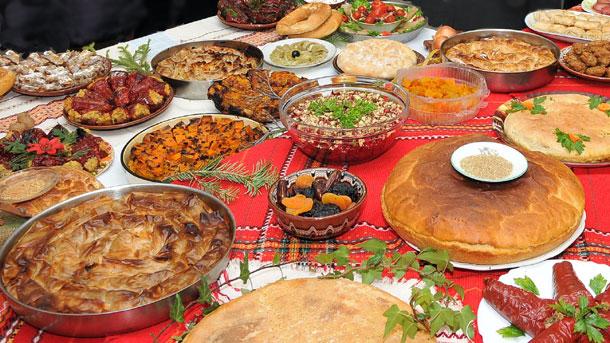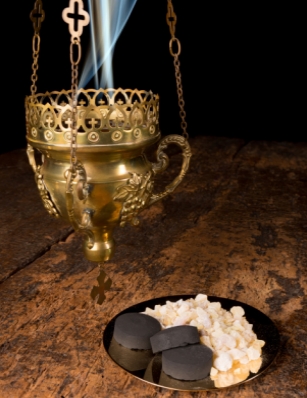Christmas Eve, festive dinner, ritual thurification… All of them words used to describe rituals, embodying the festive spirit of Christmas Eve. Families are brought together by the warm glow of home, the ritual meal, the sense of belonging, of mystery. On any other day of the year we may never stop in our tracks in search of novel sensations; on Christmas Eve however we invariably endeavor to hold on to tradition as it was handed down to us. Or – as we have read about it.
Nowadays this day seems to revolve around the preparations for the festive meal, still there are other elements of folklore tradition that are still alive. Once, a budnik (yule-log) would be got ready early in the morning – a log to be put into the hearth and burn through the night to keep the fire going. When the men went out to chop it down, they had to be careful not to let it touch the ground; they would pick it up at once and take it home with much pomp and ceremony. For the budnik they would choose a tree that was robust and prolific – a big oak, beech or pear tree. In some parts of the country a young man dressed in his finest clothes would step into the yard carrying the log and ask: “Do you give glory to the young God?” And the rest of the family would answer: “We give glory and bid you welcome!” Then the young man would bring the log into the house saying: “I enter the house and God with me!”

But it wasn’t just the log or the fire, all Christmas Eve rituals were devoted to the birth of the young God, to the young Sun coming to bring warmth and life. The ancient pagan rituals were used as the basis for adapting the biblical story of the birth of Christ. Christmas Eve signals the start of the so-called “unclean days”, a time of nature’s rebirth. This is a period spanning 12 days – the time the Virgin Mary was in travail, the birth of the infant Jesus and his baptism on Epiphany (voditsi), January 6. According to popular belief this was a time when evil and unclean forces ran wild, so different prohibitions were in place. Right up until Epiphany laundering was forbidden – the water had not been blessed yet – so was going out after dark, work of any kind etc.

 Once the meal was ready, the oldest man of the house would thurify it with incense; he would then go and thurify all rooms in the house as well as all outbuildings for the animals. Before the family sat down to table, he would break the ritual bread. In some parts of the country, a coin is put inside – this part of the ritual is now part of latter-day tradition. The first piece of bread is set aside for Virgin Mary and is then placed under the icon. The meal starts early – so the wheat will ripen early. No one should leave the table – or luck will flee (the hens will stop laying eggs). It is believed that if you sneeze during dinner, you will have many successes. To this day telling fortunes using walnuts is a popular practice. If the first walnut you pick up has a good, fresh cornel, then the year will be a good and full one. All thurified food is imbued with magical powers. That is why some of it would be set aside and taken to the stock and the fields. Being a symbol of all of the fruit of the Earth, the ritual table is not cleared until morning. It is believed that at midnight the skies open up, the barriers between the worlds are lifted and the souls of our forefathers come to our table. Again at midnight the nativity peal of church bells blends in with the songs of the Christmas singers who go from house to house to bless the households. Having come down to us from the oldest layers of our traditional culture, this is a custom that is performed to this day in different parts of Bulgaria. Because human endeavor for peace and understanding, for health and prosperity knows no bounds.
Once the meal was ready, the oldest man of the house would thurify it with incense; he would then go and thurify all rooms in the house as well as all outbuildings for the animals. Before the family sat down to table, he would break the ritual bread. In some parts of the country, a coin is put inside – this part of the ritual is now part of latter-day tradition. The first piece of bread is set aside for Virgin Mary and is then placed under the icon. The meal starts early – so the wheat will ripen early. No one should leave the table – or luck will flee (the hens will stop laying eggs). It is believed that if you sneeze during dinner, you will have many successes. To this day telling fortunes using walnuts is a popular practice. If the first walnut you pick up has a good, fresh cornel, then the year will be a good and full one. All thurified food is imbued with magical powers. That is why some of it would be set aside and taken to the stock and the fields. Being a symbol of all of the fruit of the Earth, the ritual table is not cleared until morning. It is believed that at midnight the skies open up, the barriers between the worlds are lifted and the souls of our forefathers come to our table. Again at midnight the nativity peal of church bells blends in with the songs of the Christmas singers who go from house to house to bless the households. Having come down to us from the oldest layers of our traditional culture, this is a custom that is performed to this day in different parts of Bulgaria. Because human endeavor for peace and understanding, for health and prosperity knows no bounds.
English version: Milena Daynova
In the Bulgarian folk tradition, the feasts of Lazarus Saturday and Palm Sunday are related holidays. From Lazarus Saturday (Lazarovden in Bulgaria), girls prepare for the ritual kumichene, which is performed on the morning of Palm Sunday. A very old..
In April and May the visitors of the Strelcha Historical Museum will have the opportunity to get acquainted with the traditions connected with the Easter holiday cycle through the exhibition A Fine Easter, a Finer St. George’s Day . Easter..
Lazarus Saturday is widely known in Bulgaria as Lazarovden , celebrated by Orthodox Bulgarians on the day before Palm Sunday. The main rite is the lazaruvane - a traditional custom centred on themes of love and marriage. Girls over the age of 16,..

+359 2 9336 661
